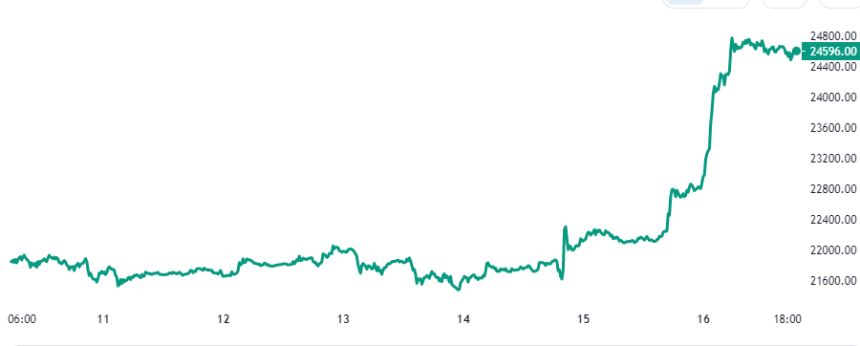Reason to trust

How Our News is Made
Strict editorial policy that focuses on accuracy, relevance, and impartiality
Ad discliamer
Morbi pretium leo et nisl aliquam mollis. Quisque arcu lorem, ultricies quis pellentesque nec, ullamcorper eu odio.
Bitcoin has broken above $24,000 in the last 24 hours as on-chain data shows a sharp spike in the stablecoin exchange inflows.
Stablecoin Exchange Inflows Have Been Elevated Recently
As pointed out by an analyst in a CryptoQuant post, there is likely demand from institutional investors in the market right now. The relevant indicator here is the “stablecoin exchange inflow mean,” which measures the mean amount of stables that are currently being deposited into the wallets of centralized exchanges.
When the value of this metric is high, it means the average number of stablecoin tokens flowing into exchanges is quite high right now, suggesting that large players might be involved.
Investors usually convert their coins into stables to escape the volatility associated with assets like Bitcoin. When these holders eventually feel that prices are right to jump back into the volatile markets, they generally transfer their stablecoins to exchanges for swapping into their desired coins.
This transfer into cryptocurrencies like Bitcoin can provide a bullish effect on their prices. Thus, whenever the stablecoin exchange inflows are elevated, there is a chance that the prices of the assets in the sector may observe a boost.
The counterpart indicator to the exchange inflow mean is the exchange outflow mean, which naturally measures the average amount of the stables exiting these platforms.
Now, here is a chart that shows the trend in the 7-day moving averages (MAs) of these two stablecoin indicators over the past couple of years:

Looks like the 7-day MA values of the metrics have been elevated in recent days | Source: CryptoQuant
As displayed in the above graph, both the 7-day MA stablecoin exchange inflow mean and outflow mean have seen pretty high values recently, but the former metric’s surge has been much higher.
A large inflow (or outflow) mean suggests that a lot of the individual transactions taking place must be carrying pretty large amounts (otherwise the average would have been low), thus implying the presence of institutional investors in the market.
These indicators, alone, however, don’t confirm just how big this presence is, as the mean of the inflows can be easily skewed by a few large investors if the total number of inflow transactions itself is low.
To check for this, there are two other metrics: the “exchange depositing transactions” and the “exchange withdrawing transactions.” The below chart shows the trend in these indicators for stablecoins, as well as how they have apparently influenced the Bitcoin price, over the past two years.

Only one of the metrics seems to have been at high levels recently | Source: CryptoQuant
From the graph, it’s apparent that the stablecoin exchange depositing transactions have been high recently, but the withdrawing transactions have been low. The fact that the inflow mean is still high despite such a high number of transactions might confirm that there is decent demand from institutions currently.
The quant has also marked in the chart what has transpired for the Bitcoin price when such a trend has historically formed. It seems like such demand for converting stables (while demand to withdraw them is absent) has generally had a bullish effect on the price.
And indeed, following the latest formation of this trend as well, BTC has observed strong upwards momentum and has crossed the $24,000 mark.
Bitcoin Price
At the time of writing, Bitcoin is trading around $24,600, up 8% in the last week.

BTC has sharply surged in the past 24 hours | Source: BTCUSD on TradingView























